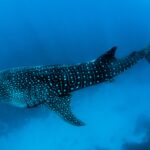Sharks are one of the most famous and feared species on the whole planet.
From their rows of razor-sharp teeth to their ability to a single drop of blood from far away, it’s no wonder they are so feared.
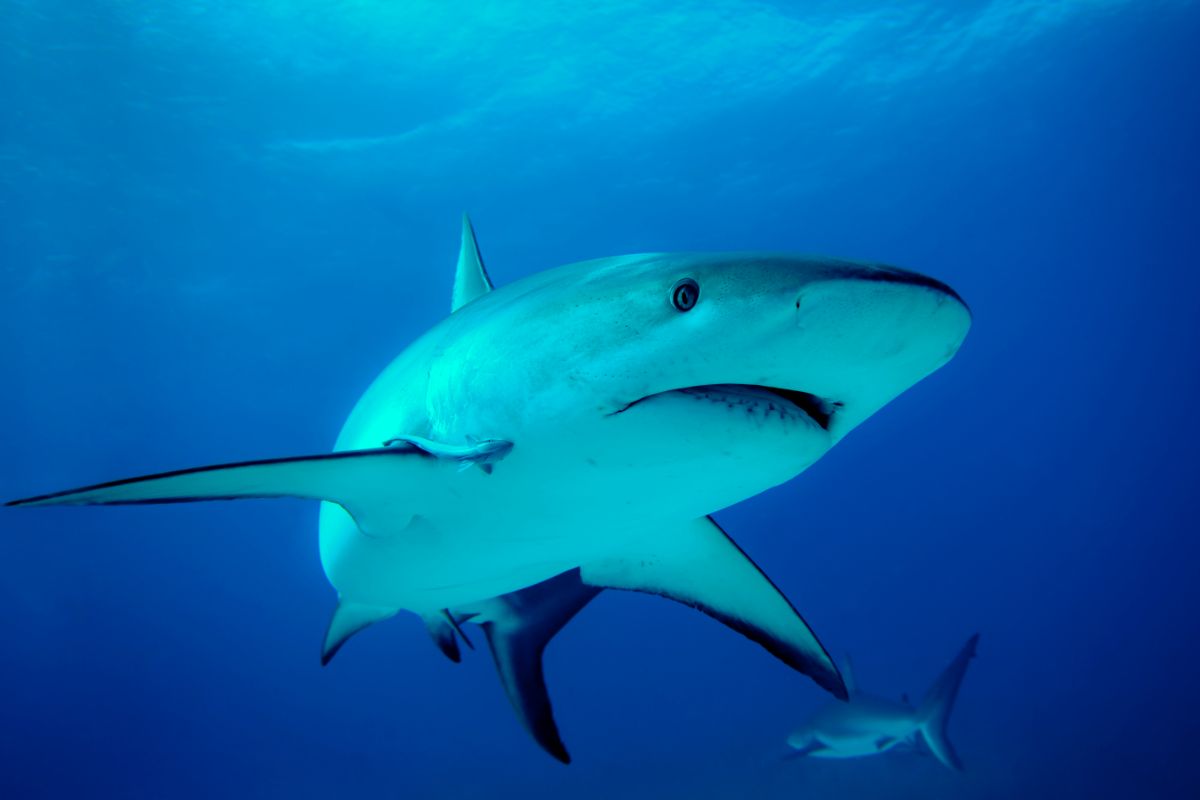
They are the perfect aquatic predator, capable of taking on not just other fish, but humans as well.
When you’re in the water, it is very much their domain and they are the kings of the sea. Unfortunately, though, this doesn’t stop sharks from being hunted.
It is estimated that around 100 million sharks are killed by people each year, and this has caused a lot of species of sharks to become incredibly vulnerable and endangered.
What most people may not realize is that sharks are absolutely vital to the ecosystems they are found in.
Without the influence of sharks in their habitats, it can cause dramatic changes to these ecosystems that are not beneficial for the earth.
We’ve put together a list of 15 of the world’s most endangered sharks, their current endangered status, and everything else you need to know about these wonderful creatures.
So let’s get started.
What Is A Shark?
We all know what a shark is and what most of them look like, but let’s get a bit more familiar with what a shark actually is.
Sharks are a subclass of fish called Elasmobranchii. All fish that are a part of this subclass have skeletons that are made from cartilage rather than bone.
Other characteristics of the Elasmobranchii subclass include five to seven gill slits on each side of their heads, which allow them to filter oxygen from the water around them.
Sharks are one of the most famous predators on the whole planet.
We’ve all seen or heard of the widely popular film Jaws in which a boat crew and small town are terrorized by a Great White Shark.
Though this shark is more of a human-eating shark, the vast majority of sharks actually don’t have a taste for human flesh.
They do attack humans on occasion, but it’s more out of defense or curiosity rather than hunger.
Sometimes, it’s as simple as sharks mistaking humans for their usual prey.
Where Are Sharks Found?
Sharks are one of the few animal species that can be found all over the world.
There are over 500 species of sharks and they can be found in every single ocean, including the Arctic Ocean. This actually includes under the arctic ice too.
Though they can be found in each ocean, the different species of sharks will change depending on the location.
There are some types of sharks that you’ll only find in one place. But in general, sharks can be found everywhere.
Vulnerable, Endangered, & Critically Endangered Status
Before we get into the actual list of endangered sharks, it’s important for you to understand what the endangered status of each shark means.
Species that are threatened by extinction are divided up into three categories, Vulnerable, Endangered, and Critically endangered.
Here’s what each of these statuses means:
- Vulnerable (VU): A species that is considered to be facing a high risk of extinction in the wild.
- Endangered (EN): A species that is considered to be facing a very high risk of extinction in the wild.
- Critically Endangered (CR): A species that is facing an extremely high risk of extinction in the wild.
Critically Endangered species are the most vulnerable class of these three statuses, whereas Vulnerable is the least.
All three statuses require that the species are carefully monitored though, to minimalize the risk of them going extinct.
Each of the sharks in this list falls into one of these categories.
15 Types of Endangered Sharks On Earth
Now that you have a better understanding of sharks and the different endangered statuses, we can jump right into the list of the 15 most endangered sharks on earth. So let’s begin.
Brown Shyshark
Kicking off the list we have the Brown Shyshark. Its current status is listed as Vulnerable.
The Brown Shyshark can usually be found off the coast of South Africa in the western area of the Atlantic Ocean.
They are a smaller species of shark with broad heads and a stocky body.
One of the main reasons the Brown Shyshark is on this list is because they are regularly caught by surf and rock anglers.
They are caught unintentionally as well so that only makes it more of a tragedy that they are listed.
When these anglers and fishermen do catch them, they consider it to be a pain and inconvenience because they are not the fish that the fishermen actually want.
This has become a problem for the species though because this fishing is detrimental to their population and this is why they are deemed Vulnerable.
Dusky Shark
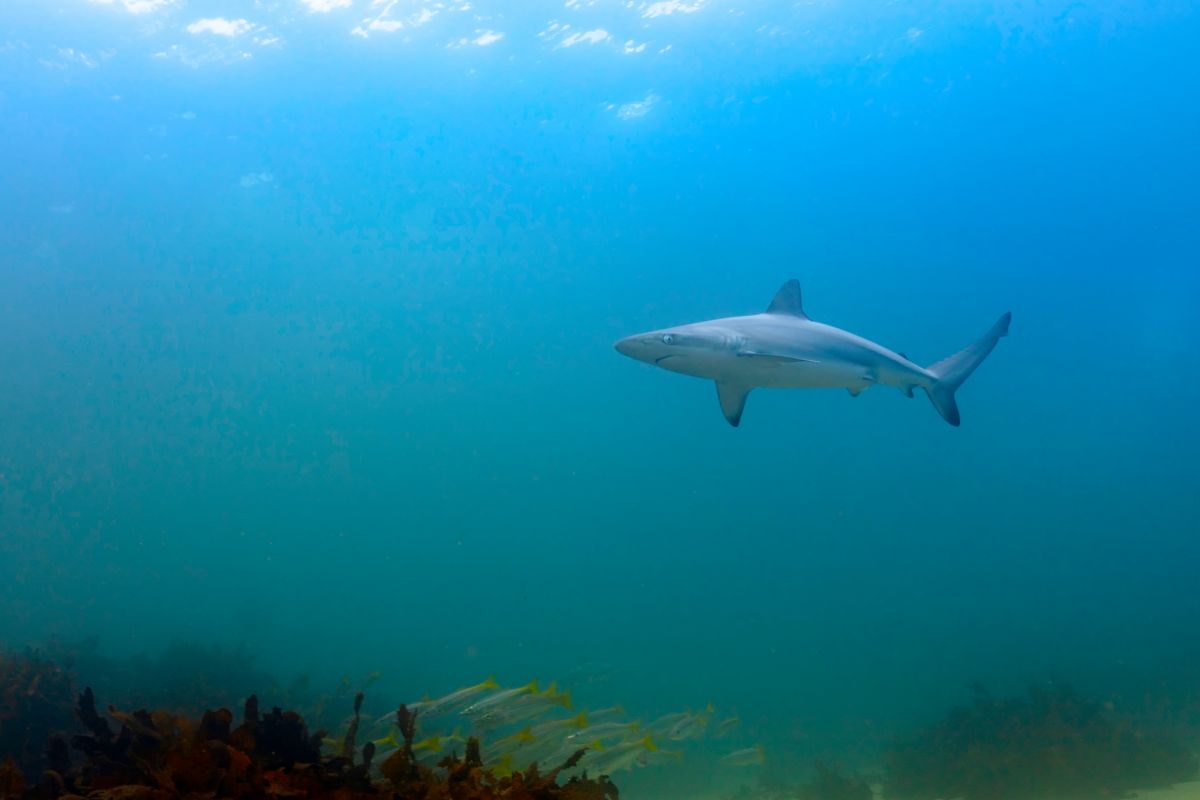
The Dusky Shark currently has the status of Vulnerable.
They can usually be found in the western Atlantic Ocean, from Massachusetts all the way down to Southern Brazil.
They can also be found around the Bahamas and Cuba. They are a warm-water species that is one of the slowest-growing of all the sharks.
Their litter sizes are also really small, so their natural way of life doesn’t help with their endangered status.
The Dusky Shark has a slender body that helps them traverse through the water quickly and they also have a unique feature in the form of a protective third eyelid on their eyes.
Along with sea turtles and whales, the Dusky Shark is one of the most at-risk of all vertebrates.
They are usually caught in the crossfire of fishermen looking for other fish, but they are also hunted for their fins.
The fins of the Dusky Shark are of such high value because they are used in shark fin soup, which is considered to be a delicacy in some Asian countries.
This unfortunately makes this species of shark much more endangered.
Because their numbers have decreased so dramatically, it is believed that it could take up to 400 years for the Dusky Shark to regrow its population to safer numbers.
Basking Shark
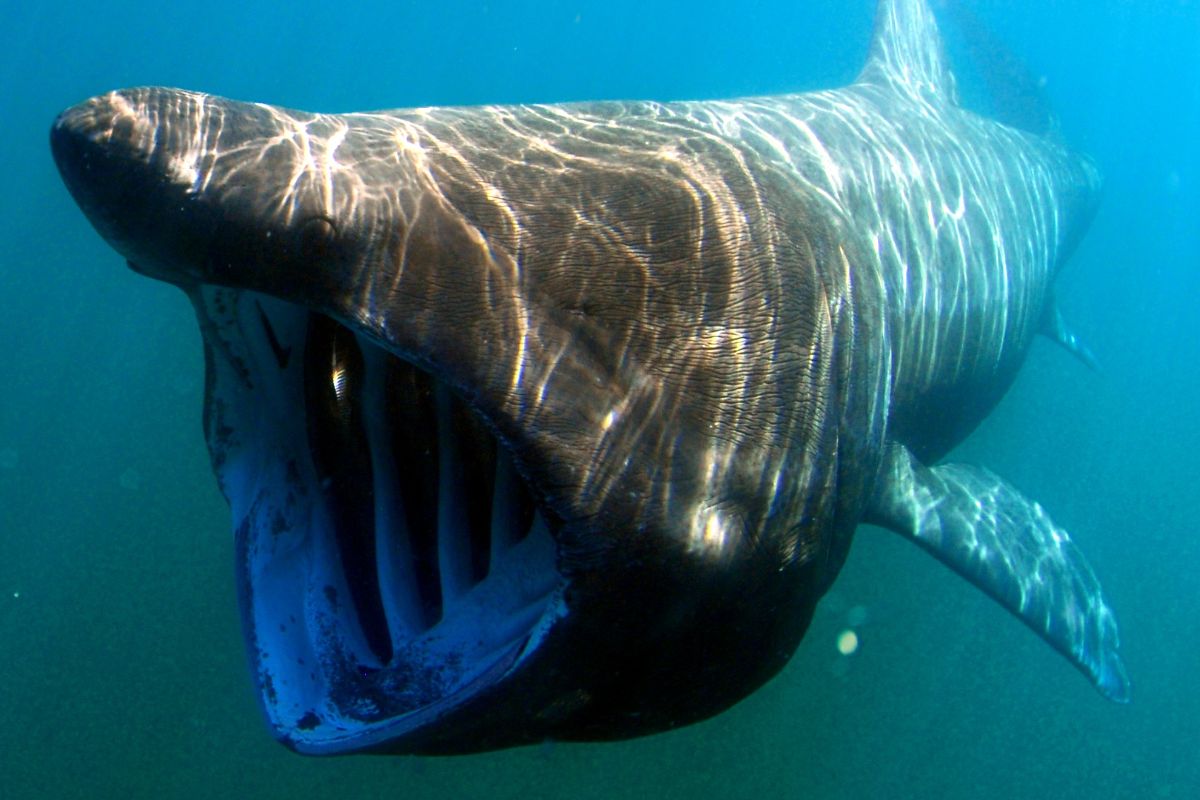
The Basking Shark currently has the status of Endangered. They can usually be found in colder waters, such as the arctic or Atlantic oceans.
They can be found in Newfoundland, Florida, Iceland, Norway, and many locations in between.
They are a very slow-moving species of shark that are very large in size. They have very large mouths that are perfect for catching lots of food and prey.
They are also a migratory species of shark, so that’s why they can be found in so many locations and areas.
The reason the Basking Shark is so endangered is that its fins are highly sought out.
Their cartilage is also used in traditional Chinese medicine, so this is another reason their population has declined enough for them to have Endangered Status.
The Basking Shark is protected in certain waters and territories, but that still doesn’t stop overfishing and hunting.
Their population numbers are also on a rapid decline anyway, so this further solidifies the Endangered Status.
Great White Shark

The Great White Shark currently has the status of Vulnerable.
They can be found in lots of locations such as northern Japan, southern Australia, New Zealand, southern Africa, off the coasts of the northeastern and western United States, and Chile.
The Great White Shark is probably the most famous and well-known of all the sharks and it might surprise you to find out that they are actually an endangered species.
Great Whites saw a rise in popularity after the release of the film Jaws.
They are famously mistaken to be man-eating sharks, but humans are actually not their preferred choice of food.
The reason the Great White Shark is endangered is that its populations have rapidly declined over recent years.
They are also heavily targeted by commercial fishing and parts of their body such as the jaws and fins are highly sought after.
Because of the negative media attention, this species of shark has received, this also makes them targets just because there is a stigma attached to their name.
Porbeagle Shark
The Porbeagle Shark is currently listed as being Vulnerable and it can be found in areas such as the North Atlantic, southern Atlantic, Indian, and Pacific Oceans.
The Porbeagle Sharks are both coastal and oceanic sharks. Unfortunately, they have a very low reproduction rate and are targeted in commercial fishing frequently.
These are the main two reasons why the Porbeagle Shark is considered to be endangered.
Those of these species that are found in the North Atlantic Ocean are actually critically endangered.
They are targeted for sports fishing by fishermen in the North Atlantic because of the popularity of the meat.
There have been conservation efforts in regard to this species, but the North Atlantic population still hasn’t recovered from sports fishing.
Sand Tiger Shark

The Sand Tiger Shark currently has the status of Vulnerable.
They are usually found along sandy coastlines, especially in areas such as Japan, Australia, South Africa, and both North and South America.
Their distinct feature is their pointed noses, which can grow up to 10.5 feet in length.
In terms of offspring, the Sand Tiger Shark can only produce 1 or 2 pups in their litter.
Coupled with the annual rates of reproduction in the species, this makes their population increase incredibly low.
They are also another target species of commercial fishing and their habitats are at risk because of this fishing, as well as pollution, beach meshing, and even spearfishing.
Luckily, they are protected in the United States and Australia, but they aren’t in their other known locations.
Whale Shark

The Whale Shark currently has the status of Endangered. They can be found in the tropical oceans of the world.
The Whale Shark is actually the largest living fish on earth. They can live to be up to 100 years old and they can grow to massive lengths of 40 feet.
The main reason the Whale Shark is endangered is because of fishing.
They get caught up in commercial fishing and end up as bycatch, especially in areas where there are large quantities of these huge sharks.
Because they are so huge, they generally tend to sustain injuries when they are caught and in some cases, they can be killed.
Hunting Whale Sharks is actually banned in places like the Philippines, India, and Taiwan, but unfortunately, they are still hunted regardless.
Scalloped Hammerhead

The Scalloped Hammerhead currently has the Critically Endangered status.
It can be found in locations such as South Africa, the Red Sea, the Indian Ocean, Japan, Hawaii, and Australia.
They can also be found in some parts of the Atlantic Ocean, such as Brazil and New Jersey.
One of the biggest threats to the Scalloped Hammerhead’s existence is the interest in their fins.
They are highly sought after and hunted because they have more fins than a lot of other shark species.
On top of being hunted for their fins, they are targeted in fishing circles because fishing is highly unregulated.
Daggernose Shark
The Daggernose Shark currently has the status of Critically Endangered.
They can be found in locations such as the Atlantic Ocean and the Caribbean Sea, as well as northern Brazil, Venezuela, Trinidad, Guyana, and Suriname.
It is one of the smaller shark species, usually reaching lengths of 4.9 feet at most and they also have large pectoral fins and long noses.
Their population has seen a rapid decline over the past decade because they have slow reproductive rates, which in turn means there are fewer Daggernose Sharks being born each year.
They are also victims of bycatch and commercial fishing in general, which is causing a lot of issues in their population growth.
Daggernose Sharks are also in danger because of limited distribution and life-history traits.
The dramatic decline of their population is so detrimental that they have had to be labeled as critically endangered.
The Daggernose Shark is one of the most critically endangered sharks on this entire list.
Smoothback Angel Shark
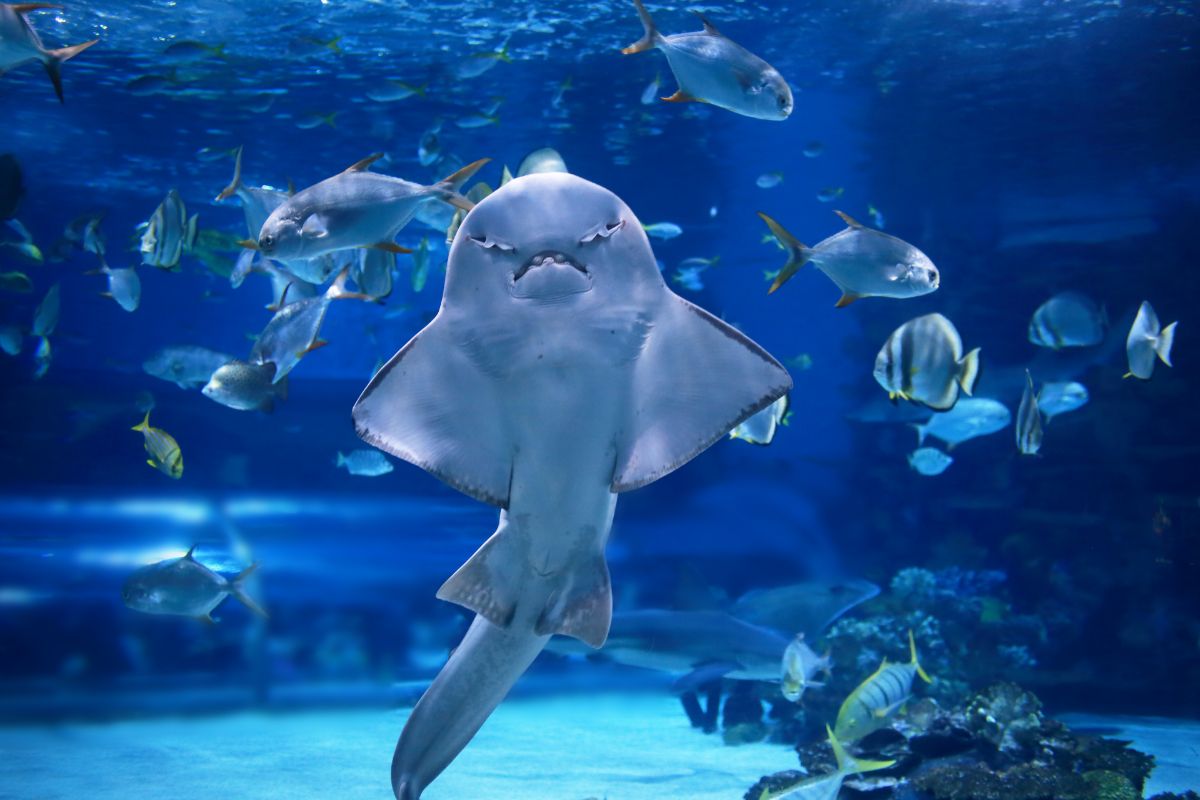
The Smoothback Angel Shark currently holds Endangered status. They can be found in the Mediterranean Sea and Eastern Atlantic Ocean.
They can be found in places off the coasts of Brazil and Uruguay. They get their names from their smooth backs and they are usually a pale, yellowy color.
The biggest reason they are an at-risk species of shark is because of their low birth rates. Another reason for their Endangered status is because of overfishing.
Striped Smooth-Hound

The Striped Smooth-hound is currently listed as Critically Endangered. This species of shark can be found in the waters around Argentina and Brazil.
It is a subspecies of Houndshark known for its unique striped pattern on its back and they usually grow to be about 5 meters in length.
One of the main reasons these Striped Smooth-hounds are so endangered is because their breeding and nursing areas are usually in the center of highly sought-out fishing areas.
This was especially a problem between the years 1994–1999.
During this time, so many of the females and shark pups were killed due to the fishing activity that the species as a whole was deemed Critically Endangered.
The Striped Smooth-hound is one of the species of shark on this list that is in serious danger and they could see a further decline in their population numbers.
Sawback Angelshark
The Sawback Angelshark is currently listed as Critically Endangered.
They can be found in locations such as West Africa, Southwestern Europe, and in large quantities in the Mediterranean Sea.
They have a row of thorns on their back that go from their heads to their tails.
Unfortunately, the areas and locations they can usually be found have become subject to demersal fisheries and this has caused a rapid decline in their population numbers.
Though they used to be found all over the place in their known areas, it’s now extremely uncommon to be able to find a Sawback Angelshark.
The areas in which you’d find a Sawback Angelshark are also highly unregulated in terms of fishing, which also contributes to the decline in their population.
There is also serious concern that their numbers will continue to decline further over the next few years.
Ganges Shark
The Ganges Shark currently holds the status of Critically Endangered.
They can be found in the Ganges, Brahmaputra, Mahanadi, and Hooghly rivers, which are all located in India.
The Ganges Shark is usually small and brown in appearance and they have what is described as a “blunt” nose.
The longest lengths they grow to are about 6 to 7 feet.
The issue with the Ganges Sharks is that they can only be found in a particular habitat, and this habitat is continuously at risk because of human interference.
On top of that, they are also victims of overfishing and pollution, which is why they are considered to be Critically Endangered.
As soon as they were given the status of Critically Endangered, the Indian Government banned all shark fishing in the Ganges River.
Pondicherry Shark
The Pondicherry Shark is currently listed as Critically Endangered. They can be found in the Indian Ocean, specifically in the Gulf of Oman near New Guinea.
The Pondicherry Shark is easily distinguished by its pointed snout and black tips on its fins. They usually grow to be about 3 ½ feet in length.
The main reason the Pondicherry Shark is so endangered is that they are victims of heavy, unregulated fishing within the areas they can be found.
No one has actually seen a Pondicherry Shark since 1979, and there are talks that this shark could already be extinct.
Northern River Shark
And finally, we have the Northern River Shark. This shark is currently listed as being Critically Endangered.
They can usually be found in locations such as Australia and New Guinea.
They are an incredibly rare species of shark that you’re very unlikely to ever see in person.
They can grow in length to just over 8 feet, their bodies are quite stocky, and their backs are described as being quite “high”.
It is believed that the current population of Northern River Shark is only 250 adults, so that makes the population of this species incredibly at risk.
The biggest threat to this shark species is bycatching.
Conclusion
You may have come across some sharks on this list that surprised you, such as the Great White Shark or the Hammerhead.
You may have come across some sharks on this list you’ve never actually heard of before.
The biggest reasons why most of these sharks are endangered is because of bycatching, overfishing, and in some cases, just low birth and reproduction rates.
With climate change and pollution forever a looming threat as well, this just makes the population of shark species even more critical.
If you fish yourself, it is important to stick to regulations. There are lots of species that are endangered, and they, unfortunately, don’t just stop with sharks.
In order to stop the rapid decline in the populations of these wonderful creatures, we need to first understand what causes the decline.
Only then can we hope to do something about it.
- Is It Possible For A Shark To Swim Backwards? - August 2, 2022
- Are Leopard Sharks Dangerous? - August 2, 2022
- What Are The Differences Between Shark And Dolphin Fins? - August 1, 2022




